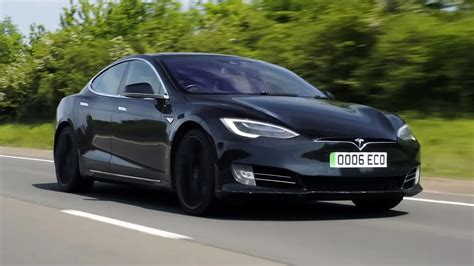
A Tesla Model S, boasting over 400,000 miles, is challenging common misconceptions about electric vehicle (EV) battery degradation, as revealed by automotive expert and YouTuber, Jason Hughes. Hughes, known for his expertise in Tesla vehicles and EV technology, dismantled and inspected the battery pack of the high-mileage Tesla, finding it to be in significantly better condition than many anticipate after such extensive use. The findings directly contradict the narrative of rapid battery degradation in EVs, suggesting that modern EV batteries are more durable than perceived.
Hughes’s investigation centered on a 2013 Tesla Model S 85, a relatively early model in Tesla’s production run. The vehicle’s odometer reading presented a unique opportunity to assess long-term battery performance under real-world conditions. According to Hughes, the battery still retains a substantial amount of its original capacity, defying expectations of drastic degradation. This challenges the widely held belief that EV batteries rapidly lose their ability to hold a charge and require frequent replacements, thus alleviating concerns among potential and current EV owners about long-term reliability and maintenance costs.
The examination process involved a detailed analysis of the battery’s individual modules and cells. Hughes’ team measured the internal resistance and capacity of each cell, providing a comprehensive overview of the battery pack’s overall health. The collected data indicated that the battery had experienced some degradation, as expected, but the extent of it was far less severe than many experts and consumers predicted. He stated, “The battery is still in surprisingly good condition overall,” which underscores the robustness of Tesla’s battery technology.
Hughes’s findings are particularly relevant in addressing consumer concerns regarding the long-term cost of EV ownership. Battery replacement costs have historically been a significant deterrent for potential EV buyers. If batteries can maintain a high percentage of their original capacity even after hundreds of thousands of miles, the overall cost of ownership becomes more competitive compared to traditional gasoline-powered vehicles.
The battery’s performance also highlights the effectiveness of Tesla’s battery management system (BMS). The BMS plays a crucial role in monitoring and controlling battery temperature, charge levels, and overall health. By preventing overcharging, excessive discharging, and thermal runaway, the BMS extends the battery’s lifespan and ensures optimal performance. Hughes acknowledged the importance of the BMS, stating, “Tesla’s battery management system is a key factor in the longevity of these batteries.”
Moreover, the real-world data from this high-mileage Tesla reinforces the environmental benefits of EVs. By demonstrating the long-term durability of EV batteries, it underscores the sustainability of electric vehicles as a viable alternative to internal combustion engine vehicles. The reduced need for battery replacements translates into less resource consumption and waste, contributing to a greener transportation ecosystem.
The implications of Hughes’s research extend beyond just Tesla vehicles. The findings offer valuable insights for the broader EV industry, suggesting that advancements in battery technology and management systems are steadily improving the durability and longevity of EV batteries across different manufacturers and models. This could lead to increased consumer confidence in EVs and accelerate their adoption rates globally.
One of the significant takeaways from this analysis is the reassurance it provides to prospective EV buyers who are hesitant due to battery-related concerns. Knowing that a Tesla Model S can withstand over 400,000 miles with reasonable battery degradation can alleviate anxieties about the long-term viability of EVs as a primary mode of transportation. It also challenges the narrative perpetuated by some critics of EVs who often cite battery life as a major drawback.
Hughes’s detailed examination serves as a valuable resource for both EV enthusiasts and skeptics alike. By providing concrete data and insights into the actual performance of a high-mileage EV battery, he has contributed to a more informed and nuanced understanding of electric vehicle technology. His work also encourages further research and development in battery technology to enhance durability, efficiency, and sustainability.
Furthermore, Hughes’s work emphasizes the importance of independent testing and analysis in the EV industry. While manufacturers often provide data on battery performance, independent evaluations offer an unbiased perspective, helping consumers make well-informed decisions based on real-world evidence. Such transparency is crucial for building trust and promoting the widespread adoption of EVs.
The enduring performance of the Tesla Model S battery also underscores the potential for second-life applications. Once a battery is no longer suitable for use in a vehicle, it can be repurposed for stationary energy storage, such as grid stabilization or home energy storage systems. This extends the battery’s useful life and reduces waste, further enhancing the sustainability of EVs.
In conclusion, Jason Hughes’s examination of the high-mileage Tesla Model S battery provides compelling evidence that challenges common EV battery myths. The battery’s robust performance after over 400,000 miles highlights the advancements in battery technology and the effectiveness of Tesla’s battery management system. This development is crucial for increasing consumer confidence in EVs and accelerating their adoption as a sustainable transportation solution. The findings reinforce the long-term viability of electric vehicles and underscore their potential to transform the automotive industry and reduce carbon emissions. The data is a significant win for electric vehicle advocates and a strong indication that EV batteries are more resilient and durable than previously thought.
Detailed Analysis and Background Information:
To fully appreciate the significance of Hughes’s findings, it is essential to delve deeper into the technical aspects of EV batteries and the factors that influence their lifespan. EV batteries are complex systems comprising numerous individual cells, each containing electrodes and electrolytes that facilitate the flow of ions during charging and discharging. The performance of these cells degrades over time due to chemical reactions, mechanical stress, and thermal effects.
Several factors contribute to battery degradation, including:
- Cycle Life: Each charge and discharge cycle causes gradual wear and tear on the battery components. The number of cycles a battery can withstand before significant degradation occurs is known as its cycle life.
- Depth of Discharge (DoD): Discharging a battery to a lower state of charge (deeper discharge) accelerates degradation compared to shallow discharges.
- Temperature: High temperatures can significantly accelerate battery degradation, while low temperatures can reduce performance.
- Charging Habits: Rapid charging (DC fast charging) can generate more heat and stress on the battery compared to slow charging (AC charging).
- Age: Even when not in use, batteries degrade over time due to gradual chemical reactions.
Tesla utilizes lithium-ion batteries in its vehicles, which offer high energy density and long cycle life compared to other battery chemistries. However, lithium-ion batteries are still subject to degradation, and Tesla has implemented several strategies to mitigate these effects.
Tesla’s Battery Management System (BMS):
As previously mentioned, Tesla’s BMS plays a critical role in optimizing battery performance and extending its lifespan. The BMS monitors and controls various parameters, including:
- Cell Voltage: Ensuring that each cell is charged and discharged within safe voltage limits.
- Cell Temperature: Regulating battery temperature through active cooling and heating systems.
- State of Charge (SoC): Accurately estimating the battery’s remaining capacity.
- State of Health (SoH): Assessing the battery’s overall condition and predicting its remaining lifespan.
- Charge Rate: Optimizing the charging rate to minimize heat generation and stress on the battery.
By actively managing these parameters, the BMS prevents overcharging, excessive discharging, and thermal runaway, which can significantly degrade the battery. Tesla also employs sophisticated algorithms to optimize charging strategies and balance the charge levels of individual cells, ensuring uniform performance across the battery pack.
Implications for the EV Industry:
Hughes’s findings have far-reaching implications for the entire EV industry. The demonstrated durability of the Tesla Model S battery challenges the prevailing perception of EV batteries as a short-lived and expensive component. This could lead to increased consumer confidence in EVs and accelerate their adoption rates.
Furthermore, the data underscores the importance of investing in robust battery management systems and advanced battery chemistries to enhance the durability and longevity of EV batteries. Other EV manufacturers can learn from Tesla’s experience and implement similar strategies to improve the performance and lifespan of their own battery packs.
The findings also highlight the potential for second-life applications for EV batteries. As the number of EVs on the road increases, there will be a growing supply of used batteries that can be repurposed for stationary energy storage. This extends the battery’s useful life and reduces waste, further enhancing the sustainability of EVs.
Impact on Consumer Confidence:
One of the primary barriers to EV adoption has been consumer concerns about battery life and replacement costs. Hughes’s research directly addresses these concerns by providing real-world evidence that EV batteries can last much longer than many people expect.
Knowing that a Tesla Model S can withstand over 400,000 miles with reasonable battery degradation can alleviate anxieties about the long-term viability of EVs as a primary mode of transportation. This could encourage more consumers to consider EVs as a viable alternative to gasoline-powered vehicles.
Economic Benefits:
The extended lifespan of EV batteries also has significant economic benefits. By reducing the need for battery replacements, the overall cost of EV ownership becomes more competitive compared to traditional vehicles. This makes EVs more accessible to a wider range of consumers and accelerates their adoption.
Additionally, the potential for second-life applications for EV batteries creates new economic opportunities. Repurposing used batteries for stationary energy storage can generate revenue and reduce waste, contributing to a more sustainable and circular economy.
Environmental Benefits:
The long-term durability of EV batteries also has positive environmental implications. By reducing the need for battery replacements, less resources are consumed and less waste is generated. This contributes to a greener transportation ecosystem and reduces the environmental impact of the automotive industry.
Furthermore, the potential for second-life applications for EV batteries reduces the demand for new battery production, which can be energy-intensive and resource-intensive. By extending the battery’s useful life, the overall environmental footprint of EVs is reduced.
Future Research and Development:
Hughes’s work underscores the importance of continued research and development in battery technology. While significant progress has been made in recent years, there is still room for improvement in terms of battery durability, energy density, charging speed, and cost.
Future research efforts should focus on:
- Developing new battery chemistries that offer higher energy density and longer cycle life.
- Improving battery management systems to optimize performance and extend lifespan.
- Developing faster and more efficient charging technologies.
- Reducing the cost of battery production to make EVs more affordable.
- Developing sustainable battery recycling processes to minimize environmental impact.
By investing in these areas, the EV industry can further enhance the appeal of electric vehicles and accelerate their adoption as a sustainable transportation solution.
Addressing Misconceptions:
Hughes’s investigation directly addresses several common misconceptions about EV batteries:
- Myth: EV batteries degrade rapidly and need to be replaced frequently.
- Reality: While battery degradation is inevitable, modern EV batteries can last for hundreds of thousands of miles with reasonable degradation.
- Myth: EV batteries are expensive to replace.
- Reality: Battery prices have been steadily declining, and the need for replacements is less frequent than many people expect.
- Myth: EV batteries are bad for the environment.
- Reality: EVs have a lower overall environmental impact than gasoline-powered vehicles, even when accounting for battery production and disposal.
- Myth: All EV batteries are the same.
- Reality: Different manufacturers use different battery chemistries and management systems, which can significantly affect battery performance and lifespan.
By providing factual information and real-world data, Hughes’s work helps dispel these myths and promote a more informed understanding of EV technology.
Conclusion:
Jason Hughes’s examination of the high-mileage Tesla Model S battery provides compelling evidence that challenges common EV battery myths. The battery’s robust performance after over 400,000 miles highlights the advancements in battery technology and the effectiveness of Tesla’s battery management system. This development is crucial for increasing consumer confidence in EVs and accelerating their adoption as a sustainable transportation solution. The findings reinforce the long-term viability of electric vehicles and underscore their potential to transform the automotive industry and reduce carbon emissions. The data is a significant win for electric vehicle advocates and a strong indication that EV batteries are more resilient and durable than previously thought. This investigation provides valuable insights for consumers, manufacturers, and policymakers alike, paving the way for a more sustainable and electrified transportation future. It encourages a shift in perception towards EVs, emphasizing their long-term reliability and economic viability, thereby promoting their wider acceptance and use. The long-term reliability of EV components, batteries included, supports a more sustainable automotive industry by reducing waste and the demand for raw materials in the long run.
Frequently Asked Questions (FAQ):
1. How much battery degradation did the Tesla Model S experience after 400,000 miles?
- While the exact percentage wasn’t explicitly stated in the Yahoo! Autos article, Jason Hughes indicated that the battery retained a substantial amount of its original capacity. His statement, “The battery is still in surprisingly good condition overall,” suggests that the degradation was less severe than commonly expected for such high mileage. A definitive percentage would require accessing Hughes’s detailed analysis and measurement data, which can often be found on his YouTube channel or other online platforms where he shares his findings.
2. What factors contribute to EV battery degradation over time?
- Several factors contribute to EV battery degradation, including cycle life (number of charge/discharge cycles), depth of discharge (how deeply the battery is discharged each cycle), temperature (high and low temperatures can accelerate degradation), charging habits (frequent fast charging can stress the battery), and age (batteries degrade over time even when not in use).
3. How does Tesla’s Battery Management System (BMS) impact battery lifespan?
- Tesla’s BMS plays a crucial role in optimizing battery performance and extending its lifespan. The BMS monitors and controls cell voltage, temperature, state of charge, state of health, and charge rate. By actively managing these parameters, the BMS prevents overcharging, excessive discharging, and thermal runaway, which can significantly degrade the battery. It also balances the charge levels of individual cells for uniform performance.
4. What are the implications of this study for potential EV buyers?
- This study provides reassurance to potential EV buyers who are concerned about battery life and replacement costs. The demonstrated durability of the Tesla Model S battery challenges the perception of EV batteries as short-lived and expensive components. It suggests that modern EV batteries can last for hundreds of thousands of miles with reasonable degradation, making EVs a more viable long-term transportation option.
5. What are the potential “second-life” applications for EV batteries after they are no longer suitable for vehicle use?
- Once an EV battery is no longer suitable for use in a vehicle, it can be repurposed for stationary energy storage, such as grid stabilization or home energy storage systems. This extends the battery’s useful life and reduces waste, further enhancing the sustainability of EVs. The battery can also be broken down for recycling, recovering valuable materials like lithium, cobalt, and nickel, which can then be used to manufacture new batteries.









